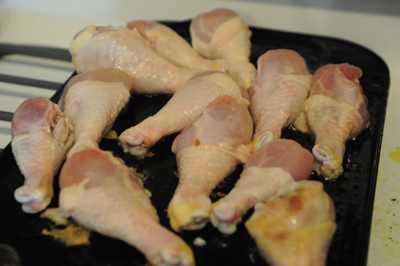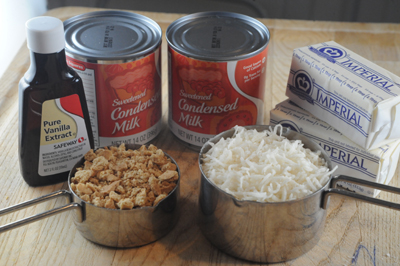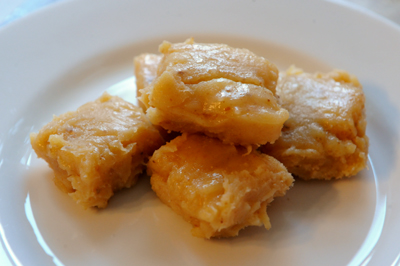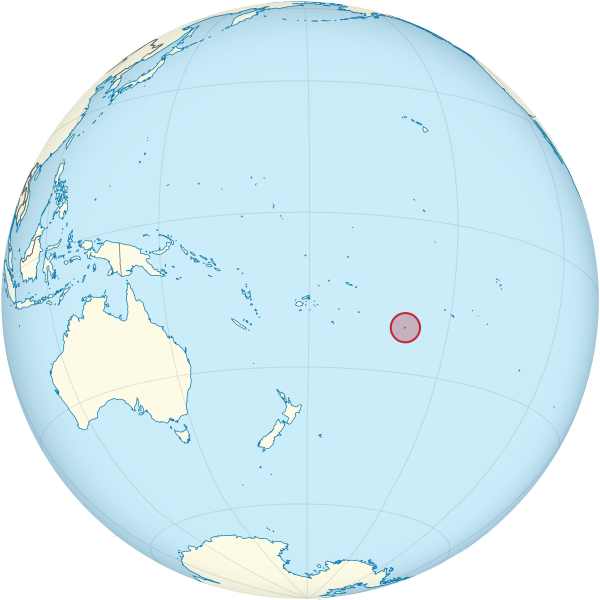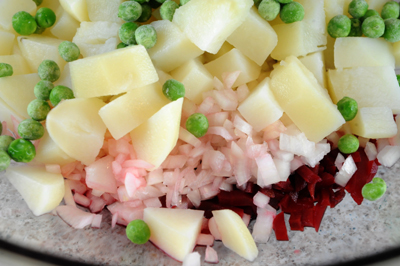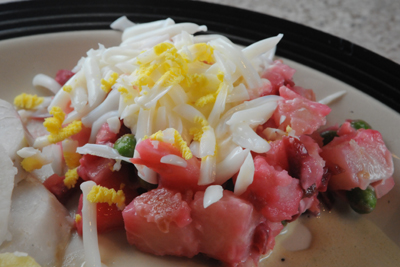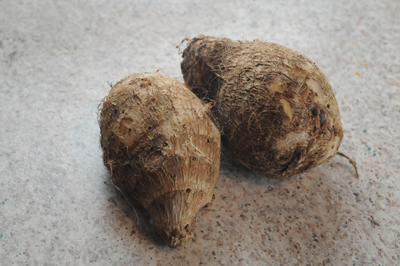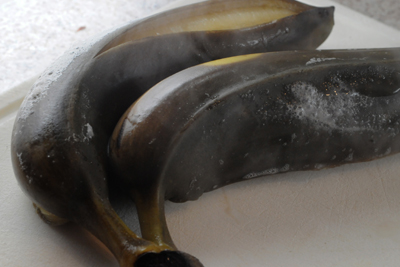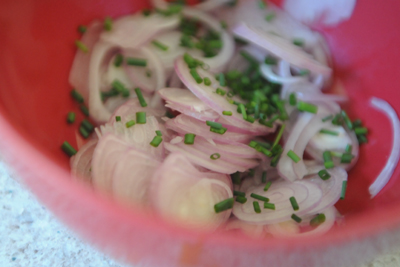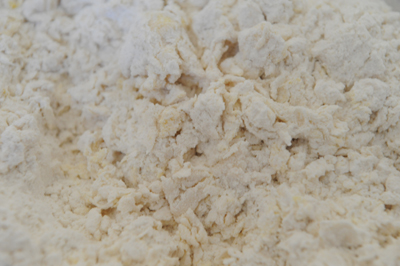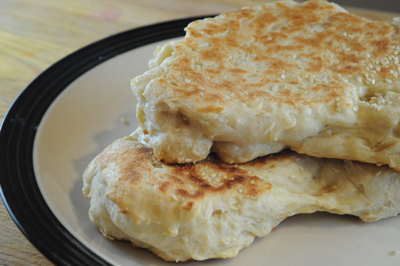So I fudged it. I'm glad I did, though, because the food I ended up making was delicious. But was it Christmas Island? Kind of, sort of.
Let me explain my process. When researching Christmas Island recipes, I found only a single possible resource. In Sydney, Australia there is a restaurant called Island Dreams Café, which specializes in cuisine from Christmas Island and Cocos (Keeling) Islands. Now you remember Cocos (Keeling), of course, which I did a few weeks ago. I did actually find a good resource for that one—and evidently the food is similar in both places, since the islands are close to each other and the populations are similar in ethnic descent, although Christmas Island has a much larger population of Chinese than it does Malay, which makes up a majority of the population on Cocos (Keeling).
But I wanted to get a recipe that I could say was actually a Christmas Island recipe, so I tracked down the owner of Island Dreams on Facebook and sent her a message. It took her a few weeks to get back to me, and when she did she wanted the link to my blog. So I sent it to her, and that was the last I heard. That was probably six weeks ago.
Now, I'm not sure if she went to my blog and was put off by the general lack of something-or-other in its author (um, cooking experience, maybe, or maybe just the blatantly Americanized ignorance of geography). More likely (I hope) she just didn't have any time to devote to getting back to me. But either way, I finally decided to just fudge and redo if I ever do find a better resource.
Anyway, let's talk about Christmas Island. As I just mentioned, it is close to and very similar to Cocos (Keeling). Like Cocos (Keeling), it is a territory of Australia, located in the Indian Ocean. There are approximately 1,500 people living there, which explains the total lack of information of any kind about its cuisine. The island was unknown until Christmas day in 1643, when a British ship sailed past it. Yes, that is how it received its name.
The island remained unexplored, though, for more than 200 years. In 1888 it was visited for 10 days by a small group of explorers who used the time to gather biological and mineralogical specimens. Their collection included a few rocks that consisted of nearly pure phosphate of lime, which of course led the British to claim the entire island shortly thereafter. Christmas Island's rich phosphate deposits (which by the way comes from bird poop) also made it a target for Japanese occupation during WWII. Eventually sovereignty was given to Australia, which still holds the territory today.
Anyway, here's what I did:
I looked at some of the restaurant reviews for Island Dreams Café and got an idea about what they serve there. Then I Googled pretty much every dish that I could find a reference to. I finally came up with this one:
Ayam Panggang (Lemon Chile Chicken)
- 2 tbsp coriander seeds
- 2 tbsp cumin seeds
- 1 tbsp fennel seeds
- 1 tbsp tamarind paste
- 1 tsp ground turmeric
- 4 stalks lemongrass, grated
- 4 kaffir lime leaves
- 6 cloves garlic
- 1 onion
- A large handful of red dried chilies, soaked
- pinch salt
- 1 1/2 cups water
- 4 lbs chicken pieces (on the bone)
- Oil
- 1 3/4 cup coconut milk
- Juice of 1 lemon
- I added cumin, to bring it a little closer to the recipe they use at Island Dreams Café.
- I added lemongrass, since I heard another review refer to the Island Dreams Café dish as "lemongrass chicken." Of course, I don't have any way of knowing how accurate that is, though I did find lemongrass in other versions of this recipe.
- I took out the shrimp paste, because ew.
- I took out the candlenuts, because I did not find them in any other version of this recipe and also because you can't get them anywhere in my local area, or online. And I mean nowhere.
- I added kaffir lime leaves, because I did find them in several other versions of this recipe.
Roti Canai
- 3 1/2 cups all-purpose flour
- 1 1/2 tsp salt
- 1 tsp granulated sugar
- 3/4 cup ghee, room temperature (divided)
- 1 large egg, beaten
- 3/4 cup whole milk
- 1/2 cup water
Roti is an unleavened bread, which means you have to do other things to it to make it less dense. Things like stretching, rolling, pressing and tearing your hair out.
By the way, you will need to start making this about eight hours before you plan to serve it. You have been warned.
So first mix the flour with the salt, sugar and about 1/4 of the ghee (yes you do need ghee for this recipe, butter would make a totally different bread). Rub the mixture together with your fingertips until it starts to get kind of clumpy.
Now add the egg, milk and water. Mix until well-combined, and then knead for 8 to 10 minutes, until you get a smooth, stretchy dough.
I, of course, did this in my bread machine. Because I love my bread machine, and am also lazy.
Now divide the dough up into eight equal-sized parts and shape them into balls. Take a teaspoon of ghee and slather it all over the first ball. Then take another teaspoon and do the second ball. Keep going until you have eight shiny balls of ghee-covered dough. Now cover them with a paper towel and let them rest for six hours (more is ok, too).
Your dough should be warm, so if you like your kitchen to be as cold as an Antarctic summer (as my husband does), you may need to microwave each dough ball for a few seconds until it is warm enough to work with. This will make it easier to stretch, which is the challenging part of this recipe.
OK now you will need a work surface that's at least two foot square, that you can cover with ghee. In the center of the workspace, put about 1 teaspoon of ghee. You will also need to cover your hands with more ghee.
Pick up the first ball and place it on the center of your workspace, where that blob of ghee is. Now flatten it with your hand until it is about six inches in diameter. Now start stretching it. Pull the dough from the center outwards, working in 3 or 4 inch sections, until you've stretched it out into a large, uniformly paper-thin circle about 2 feet in diameter. You will need to go back and redo areas as needed, concentrating on the parts that are thicker. It's very stretchy but be careful, you can still end up with holes.
Now take the sheet and roll it up loosely like a rope, trying to keep some air in between the layers (this is what replaces the yeast and makes the texture of the final bread lighter that it otherwise would be). Now drizzle the rope with another teaspoon of ghee. Yes, more ghee.
OK, pause to catch your breath. Almost done.
Coil the first rope into a loose pinwheel shape, keeping plenty of small air pockets in between the coils. Tuck the end into the center (which I didn't do, but the final product didn't suffer). Repeat with the rest of the ropes. Flip them over and let rest for five minutes.
Now flatten the first pinwheel until it is about 7 or 8 inches in diameter. Melt some (what else) ghee over low heat in a large griddle and cook the first dough until a deep golden brown on both sides. Repeat with the remaining breads.
Now when they have cooled a little, put them between your hands and "clap" a few times, which will help separate the layers. That's it. Whew, that was complicated.
OK now for the ayam panggang. But first I have to tell you about kaffir lime. I saw a package of leaves the other day at the co-op, and I thought, cool! I've never actually seen those before, and I've had to pass on loads of recipes because I had no source for them. But like a big dummy, I didn't buy them. Of course in my defense, I didn't know you could freeze them. Anyway when I went back for them the store no longer had them, which just figures because that's the kind of luck I have. So I bought a kaffir lime tree
You may think that's a little crazy, especially since the original version of this recipe didn't even call for kaffir lime leaves, but I've actually been thinking about doing this for a while. I see kaffir lime leaves in a lot of ingredient lists, especially Thai recipes. And they are supposed to be pretty good house plants. Of course, I kill most of my house plants, so we'll have to see how that works out.
So anyway, on to the recipe:
In a mortar and pestle (or spice grinder, which is what I used), crush the coriander with the cumin, fennel and turmeric. In a blender, purée the tamarind paste with the grated lemongrass, kaffir lime leaves, onion, garlic, soaked chilies and salt, adding a little water as needed, until you have a smooth paste. Add the dry spice mix and pulse until well incorporated.
Now heat some oil in a large pan and add the paste. Cook, stirring, until the mixture becomes aromatic. Then add the chicken and about 3/4ths of the coconut milk. Cook for about 30 minutes or until the chicken is tender (the internal temperature should be at least 165 for breast meat and 175 for thighs and drumsticks).
When the chicken is done, add the rest of the coconut milk and the lemon juice and stir. Serve hot over steamed rice.
I did not do this for my kids because of the whole "handful of chilies" thing. It was pretty spicy, but I used dried super peppers from my summer garden, which are kind of ridiculously hot, so the level of heat really depends on the brand of pepper.
The ayam panggang was really yummy. Martin and I both really enjoyed it. It was very much like an Indian curry, but the lemon made it really tangy and unusual. The next time I make it though (and I will), I'll probably use diced boneless-skinless thighs, which will make it a little simpler to eat. I think it was hard to get the full effect of all that yummy sauce when a lot of it was just left on the plate with the bones.
And the roti, oh my. I don't know how close mine actually came to the authentic stuff, but I made a pretty good go of it and it tasted delicious. It was both crispy and soft, which is an awesome combination in a flat bread. Like an Indian naan, it was great for scooping up excess sauce, which I wish I'd actually made a lot more of.
So although this isn't a true Christmas Island meal, it was the closest I could come given the general lack of resources on the subject. If I do ever hear back from the owner of Island Dreams Cafe, I'll post the real thing, but in the meantime who cares. I'm not one to criticize a good thing just because it's a little less than genuine.
Next week: Côte d'Ivoire (Ivory Coast)
For printable versions of this week's recipes:




















.svg/550px-Costa_Rica_(orthographic_projection).svg.png)

